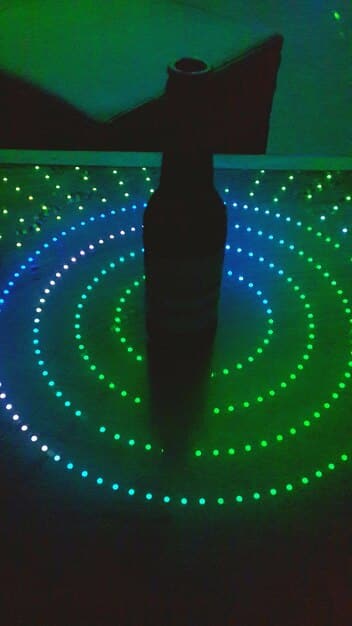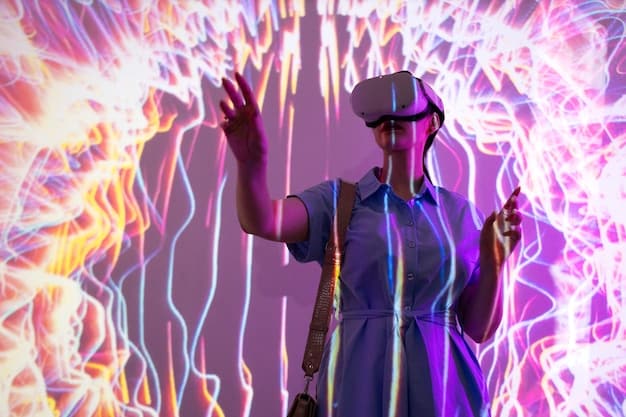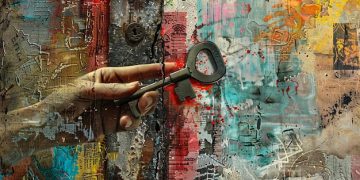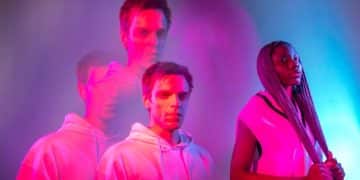The Future of Underground Music: Trends & Technologies 2025

The future of underground music, by 2025, is poised for significant transformation driven by decentralized technologies, AI-powered creativity, immersive live experiences, and evolving artist-fan relationships, challenging traditional industry structures.
As we approach 2025, the landscape of independent artistry and sonic innovation is undergoing a profound metamorphosis. The Future of Underground Music: Emerging Trends and Technologies to Watch in 2025 promises a dynamic shift, moving beyond conventional boundaries to embrace novel forms of creation, distribution, and connection.
The Decentralization of Sound: Blockchain and NFTs
The traditional music industry has long been criticized for its centralized power structures, often leaving independent artists with limited control and revenue. However, the advent of blockchain technology is rapidly rewriting this narrative, offering a decentralized paradigm that empowers creators and redefines ownership. This seismic shift is not merely theoretical; it is actively shaping how music is made, shared, and valued within underground communities.
Empowering Artists Through Transparency
Central to blockchain’s appeal is its immutable ledger system, which provides unprecedented transparency. Artists can now embed metadata directly into their tracks, ensuring clear ownership and tracking every transaction, from initial sale to secondary market resales. This eliminates the need for intermediaries who historically took large cuts, allowing artists to retain a larger share of their earnings and intellectual property. The transparency fosters a more equitable ecosystem, one where contributions are recognized and appropriately compensated. It’s a direct challenge to the opaque practices that have long plagued the industry.
NFTs: Redefining Music Ownership and Collectibles
Non-Fungible Tokens (NFTs) have emerged as a cornerstone of this decentralized future. Beyond simple audio files, NFTs allow artists to tokenize unique digital assets, ranging from singular tracks and albums to exclusive experiences, unreleased demos, or even song stems. These digital collectibles create new revenue streams and foster deeper connections between artists and their most dedicated fans. Collectors aren’t just buying music; they’re investing in unique art, becoming patrons, and participating in a new wave of patronage. The intrinsic value of the NFT often lies in its scarcity and the direct relationship it builds.
- 📈 Direct Artist-to-Fan Transactions: NFTs facilitate direct sales, cutting out distributors and labels.
- 🎁 Exclusive Content and Experiences: NFTs can unlock access to private shows, behind-the-scenes content, or even early access to new releases.
- 🤝 Royalties and Secondary Sales: Smart contracts embedded in NFTs can automatically distribute royalties to artists for every subsequent resale of their work.
The implications of blockchain and NFTs extend beyond financial benefits. They are fostering entirely new creative economies where community dictates value and artists have unprecedented creative freedom. This shift is particularly resonant in the underground, where independent ethos and direct engagement have always been paramount. By 2025, expect to see more artists leveraging these tools to build self-sustaining careers without relying on traditional gatekeepers. These technologies offer a robust framework for financial independence and artistic liberty, crucial elements for the continued flourishing of underground music as a vibrant cultural force. The power dynamic is shifting, putting more control directly into the hands of the creators and their immediate communities.
AI as a Creative Collaborator: Beyond Automation
The conversation around Artificial Intelligence in music often devolves into debates about authenticity or job displacement. However, for the underground music scene, AI represents less of a threat and more of a groundbreaking collaboration tool. By 2025, AI’s role will extend far beyond simple automation, becoming an intricate creative partner that augments human ingenuity and pushes the boundaries of sonic exploration. It offers new avenues for production and experimentation that were previously unimaginable for independent artists without significant resources.
Algorithmic Composition and Sound Design
AI-powered tools are already demonstrating impressive capabilities in algorithmic composition, generating melodies, harmonies, and even entire song structures. For underground producers, this means having a tireless assistant capable of brainstorming ideas, suggesting variations, or even creating abstract soundscapes that spark new creative directions. These tools don’t replace human intuition but rather amplify it, offering diverse starting points and inspiring novel arrangements. The AI can process vast amounts of musical data, recognizing patterns and generating outputs in a fraction of the time a human could.
Furthermore, AI-driven sound design is unlocking new sonic palettes. Machine learning algorithms can analyze existing sounds and synthesize entirely new ones, manipulating textures, timbres, and spatial characteristics with incredible precision. This allows artists to craft unique sonic identities and create immersive auditory experiences that stand out in a crowded soundscape. Imagine an AI that can learn your preferred sound signatures and generate sounds that align with your artistic vision, even surprising you with unexpected iterations.
AI-Powered Mastering and Production Assistance
Beyond pure creation, AI is streamlining technical aspects of music production, making high-quality output more accessible to independent artists. AI-powered mastering services can analyze a track’s dynamics, EQ, and stereo image, optimizing it for various playback environments. This democratizes professional-grade mastering, allowing artists to achieve polished results without expensive studio time or expert engineers. It levels the playing field significantly.
- 🎧 Intelligent Mix Analysis: AI can identify problematic frequencies or clashing instruments in a mix, offering precise recommendations for improvement.
- 🎛️ Dynamic Range Optimization: Algorithms can intelligently apply compression and limiting to ensure a consistent and impactful sound across different platforms.
- 🎵 Genre-Specific Presets: AI can adapt its processing based on the specific genre or desired aesthetic, understanding nuanced sonic characteristics.
By 2025, the integration of AI will be seamless, embedded within digital audio workstations (DAWs) and production suites, becoming an intuitive extension of the artist’s creative process. It will empower underground musicians to experiment more freely, enhance the technical quality of their output, and ultimately, produce more compelling and innovative music. The ethical considerations around AI and creativity will undoubtedly continue, but its role as a valuable collaborator in the underground, pushing artistic boundaries, is increasingly undeniable.
Immersive Experiences: Virtual, Augmented, and Beyond
The concept of a “live show” in underground music is rapidly expanding beyond traditional venues. Fueled by technological advancements and the lingering effects of global events that limited physical gatherings, immersive experiences are set to redefine how artists connect with their audience. By 2025, virtual reality (VR), augmented reality (AR), and mixed reality (MR) will no longer be niche technologies but integral components of the underground music experience, blurring the lines between physical and digital.
VR Concerts and Digital Venues
The rise of the metaverse and accessible VR headsets is paving the way for entirely new forms of live music. Artists can host virtual concerts in custom-designed digital venues, allowing fans from anywhere in the world to attend, interact, and even socialize within a shared virtual space. These VR experiences offer unparalleled creative freedom, enabling artists to build fantastical environments, incorporate interactive elements, and deliver performances that defy the constraints of physical reality. Imagine a show taking place on a distant planet, or inside a swirling vortex of sound.
Beyond one-off events, persistent digital venues are emerging, serving as community hubs where artists can host regular performances, interactive art installations, and fan meet-and-greets. These spaces foster a sense of belonging and provide new platforms for discovery, especially for niche genres that thrive in decentralized communities. The low barrier to entry for fans, often only requiring a VR headset or even a powerful computer, makes these experiences highly accessible.

Augmented Reality and Hybrid Performances
Augmented reality offers another dimension, overlaying digital content onto the physical world. For underground artists, this means enhancing traditional live shows with dynamic AR visuals that react to the music and performers. Imagine intricate visual effects appearing around a band as they play, or audience members seeing interactive digital elements through their smartphone screens, enriching their experience. These hybrid performances bridge the gap between digital innovation and physical presence, creating a unique spectacle.
- 📱 Interactive AR Apps: Fans can use their phones to unlock AR experiences at concerts, revealing hidden visual layers or additional content.
- 🎭 Location-Based AR Art: Artists can create AR soundscapes or visual installations tied to specific physical locations, transforming urban environments into interactive galleries.
- 💡 Enhanced Stage Presence: AR projections can transform a simple stage into a dynamic canvas, adding depth and visual intrigue to live acts without extensive physical setups.
By 2025, these immersive technologies will be standard tools for underground musicians, offering novel ways to connect with fans, create memorable experiences, and push the boundaries of artistic expression. They democratize access to cutting-edge performance aesthetics, allowing independent acts to rival the production values of larger acts without massive budgets. The future of live underground music is not just about listening; it’s about experiencing.
Community-Driven Creation: Crowdfunding and DAOs
The strength of underground music has always resided in its fervent communities. As we look towards 2025, these communities are evolving from passive audiences into active, empowered participants in the creative and financial lifecycle of their favorite artists. This transformation is largely driven by advancements in crowdfunding models and the emergence of Decentralized Autonomous Organizations (DAOs), fundamentally reshaping artist-fan dynamics and funding structures.
Beyond Kickstarter: Evolved Crowdfunding
Traditional crowdfunding platforms provided a vital lifeline for independent artists, allowing them to fund projects directly through fan contributions. However, new iterations of crowdfunding are emerging, offering more continuous and integrated support. Subscription-based platforms like Patreon have long fostered a direct artist-fan relationship, but now, token-gated communities are taking this a step further. Fans who own a specific artist’s NFT or social token gain access to exclusive content, private channels, and even voting rights on creative decisions. This creates a more vested interest and a shared sense of ownership.
These evolved crowdfunding models cultivate dedicated fan bases that are not just consumers but genuine stakeholders in the artist’s journey. They enable artists to sustain themselves through consistent, community-backed funding rather than relying on sporadic campaign surges. This predictive income stability allows for greater creative freedom and long-term planning, crucial for experimental and niche genres often found in the underground.
DAOs: Decentralized Artistic Governance
Decentralized Autonomous Organizations (DAOs) represent the pinnacle of community-driven creation. In the context of music, a DAO could be formed around an artist, a label, or even a collective of musicians. Members of the DAO, typically token holders, collectively make decisions about funding, project direction, collaborations, and even how revenue is distributed. This democratic governance model ensures that power is distributed among the community, aligning incentives and fostering a truly collaborative environment.
- 🗳️ Collective Funding Decisions: DAO members vote on how pooled funds are allocated for recording, touring, or visual production.
- 🎶 A&R by Community: Fans can vote on song selections, album artwork, or even which tracks get released as singles, creating a truly fan-curated output.
- 💡 Shared Ownership: In some DAOs, token holders might even share in the future success and intellectual property of the projects they fund and govern.
By 2025, DAOs will provide a robust framework for self-organizing musical ecosystems, offering a viable alternative to traditional record labels and management structures. They embody the ethos of the underground: independence, collaboration, and a rejection of centralized control. This shift empowers artists with greater autonomy and ensures that the creative direction remains deeply rooted in the desires and values of their most dedicated supporters. The future of underground music is inherently collaborative, built from the ground up by its passionate communities.
Hyper-Niche Soundscapes: Algorithms and Global Reach
The digital age has fragmented audience attention, but for underground music, this fragmentation is a fertile ground for growth. Rather than a drawback, the emergence of hyper-niche soundscapes, facilitated by sophisticated algorithms and global connectivity, is a defining trend for 2025. Algorithms, often maligned for creating echo chambers, are now becoming powerful tools for connecting highly specific artistic expressions with equally specific audiences, transcending geographical limitations.
Algorithmic Discovery and Micro-Genres
Streaming platforms and social media algorithms are becoming increasingly adept at identifying and recommending hyper-niche music. While major labels focus on broad appeal, these algorithms can highlight obscure artists operating within highly specific sub-genres, dramatically expanding their reach. This allows for the flourishing of micro-genres that might otherwise never find an audience beyond a small, local scene. From “Deconstructed Club” to “Hypnagogic Pop,” algorithms are serving as curators, connecting creators with listeners who share incredibly specific aesthetic tastes.
This algorithmic curation is a double-edged sword: it can provide unparalleled discovery for artists, but also risks creating bubbles. However, in the underground, where authenticity and specificity are prized, this precise targeting is a boon. It allows artists to focus on artistic integrity rather than chasing mainstream appeal, knowing that their highly specific work can still find its dedicated audience globally. The “long tail” of music is not just getting longer; it’s getting more intricately patterned.
Global Collaboration and Cultural Fusion
The internet has obliterated geographical barriers, fostering unprecedented global collaboration within the underground music scene. Artists from different continents can easily connect, share files, and co-create music in real-time. This has led to an explosion of cross-cultural fusion, where diverse musical traditions and contemporary sounds intermingle to create truly original and innovative soundscapes. A producer in Tokyo can collaborate with a vocalist in Lisbon, resulting in a sound that defies easy categorization.
- 🌐 Remote Jam Sessions: Cloud-based DAWs and low-latency audio solutions enable musicians to perform and record together across vast distances.
- 💻 Online Community Hubs: Dedicated forums, Discord servers, and social platforms serve as vital meeting points for artists and fans within specific micro-genres.
- 🌍 Cross-Cultural Exchange: The ease of global communication fosters a rich exchange of ideas, techniques, and cultural influences, enriching the global sound of underground music.
By 2025, the underground will be characterized by an even greater diversity of sounds, driven by highly specialized algorithms connecting niche artists with passionate global audiences. The ability to collaborate and disseminate music worldwide without traditional gatekeepers means that musical innovation will be more vibrant and unpredictable than ever before, reflecting a truly global tapestry of sonic expression. The future is distinctly decentralized and diverse, powered by smart connections rather than mass appeal.
Beyond the Mainstream: Reclaiming Authenticity
The underground has always served as a counter-narrative to the polished, often homogenized sounds of the mainstream. As we approach 2025, this distinction will become even more pronounced, with underground artists actively reclaiming authenticity through raw, unfiltered expression and a rejection of industry artifice. This movement is not just about musical style but a broader cultural stance against commercialism and curated perfection.
Raw Sonic Aesthetics and Imperfection
In an era of hyper-produced mainstream music, the underground is increasingly embracing rawer, more experimental sonic aesthetics. This means prioritizing organic textures, unconventional recording techniques, and even intentional imperfections. Lo-fi production values, harsh noise, and unpolished vocals become artistic choices that convey sincerity and urgency. The emphasis shifts from pristine sound quality to genuine emotional resonance and artistic purity. This acts as a direct counterpoint to the often over-compressed and auto-tuned sounds prevalent elsewhere.
This embrace of imperfection reflects a desire for honesty and a push against the algorithmic optimization that often dictates mainstream success. Underground artists are choosing to make music that feels human, often flawed, and deeply personal, resonating with listeners who crave something real amidst a sea of manufactured content. It’s about the message and the feeling, often more than the flawless execution.
Anti-Commercialism and Ethical Consumption
The underground scene in 2025 will continue its long-standing tradition of anti-commercialism, but with a renewed focus on ethical consumption and sustainable practices. This translates into artists consciously avoiding traditional corporate sponsorships that might compromise their artistic integrity and instead seeking support from ethically aligned brands or direct fan patronage. There’s a growing awareness of the environmental impact of tours and merchandise, prompting discussions around eco-friendly practices within the scene.
- 🌿 Sustainable Touring Practices: Artists are exploring lower-carbon touring options, including local residencies and virtual performances.
- ♻️ Eco-Conscious Merch: Merch is increasingly being produced from recycled materials or through ethical supply chains, reflecting shared values with the audience.
- 🚫 Rejecting Corporate Influence: Artists are more discerning about partnerships, prioritizing artistic freedom and community values over large commercial gains.
This return to fundamental principles of authenticity and ethical conduct defines the spirit of underground music in 2025. It’s a deliberate pivot away from the superficiality of market trends, prioritizing raw creative expression, community values, and a genuine connection with one’s art and audience. The future of underground music is not just about new sounds; it’s about a renewed commitment to integrity and an uncompromising artistic vision that truly challenges the status quo.
| Key Trend | Brief Description |
|---|---|
| 🔗 Decentralization & NFTs | Blockchain empowers artists with transparency, direct sales, and new revenue models via unique digital assets. |
| 🤖 AI Collaboration | AI assists in composition, sound design, and production, pushing creative boundaries and democratizing tools. |
| 🌍 Immersive Experiences | VR/AR performances and digital venues offer new ways for fans to engage with music globally. |
| 🌱 Community/Authenticity | Crowdfunding, DAOs, and a focus on raw expression strengthen artist-fan bonds and ethical practices. |
Frequently Asked Questions
▼
Blockchain offers unprecedented transparency in royalty distribution and intellectual property rights. By 2025, artists can leverage NFTs to sell music directly, retain more control over their earnings, and even earn royalties on secondary sales, bypassing traditional intermediaries and fostering financial independence.
▼
No, AI is more likely to serve as a creative collaborator than a replacement. By 2025, AI tools will assist with composition, sound design, and production tasks, providing artists with new ideas and streamlining workflows. This frees musicians to focus on artistic vision and experimentation, rather than technical hurdles, amplifying human ingenuity.
▼
Virtual reality will enable immersive concert experiences in digital venues by 2025, allowing global audiences to attend. Artists can create unique, interactive environments that transcend physical limitations, fostering community and offering innovative ways to perform. This expands reach and provides new artistic avenues beyond traditional gig spaces.
▼
Community involvement will deepen through evolved crowdfunding and Decentralized Autonomous Organizations (DAOs). Fans will move beyond passive consumption to active participation, funding projects, voting on creative decisions, and even collectively owning aspects of an artist’s work. This fosters stronger bonds and shared artistic ownership.
▼
While technology offers wider reach, the “underground” essence, defined by authenticity, experimentation, and independence, is expected to persist. New tools can empower artists to maintain creative control and connect directly with their niche audiences, reinforcing these core values rather than diminishing them. It’s about leveraging technology for autonomy.
Conclusion
As we navigate towards 2025, the future of underground music is remarkably bright, characterized by a potent blend of technological innovation and a steadfast commitment to artistic authenticity. From the democratizing force of blockchain and NFTs to the collaborative potential of AI and the immersive allure of virtual experiences, these advancements are not merely trends; they are foundational shifts reshaping the very essence of musical creation, distribution, and consumption. The underground will continue to be the crucible for experimentation, driven by empowered artists and deeply engaged communities, solidifying its role as the vital, unpredictable, and exciting heart of the global music landscape. This evolving ecosystem promises a vibrant space where creativity thrives unbound by traditional constraints.





